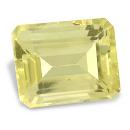|
|
||||||||||||||||
|
||||||||||||||||
|
||||||
|
|
|
|
Scapolite
(Mineral
Group) |
|
| | |
| Discovered in 1866 (Marialite); IMA status: Not Valid (Mineral Group name) | ||
|
| ||
|
Chemistry |
|
|
| |
|
(Na,Ca)4(Si,Al)12O24(Cl,CO3,SO4) | |
|
|
Sodium Calcium Aluminum Silicate Carbonate Chloride |
|
Molecular Weight: |
877.08 gm |
|
Composition: |
Sodium |
5.24 % |
Na |
7.07 % |
Na2O |
|
|
Calcium |
9.14 % |
Ca |
12.79 % |
CaO |
|
|
Aluminum |
15.38 % |
Al |
29.06 % |
Al2O3 |
|
|
Silicon |
22.42 % |
Si |
47.95 % |
SiO2 |
|
|
Chlorine |
4.04 % |
Cl |
4.04 % |
Cl |
|
|
– |
– % |
Cl |
-0.91 % |
-O=Cl2 |
|
|
Oxygen |
43.78 % |
O |
|
|
|
|
|
100.00 % |
|
100.00 % |
= TOTAL OXIDE |
|
|
|
||||
|
Classification |
|
|
| |
|
Silicates (Germanates) | |
|
8/J.13-10 | |
|
|
9 : SILICATES (Germanates)
|
|
Related to: |
Scapolite Group. Marialite-Meionite Series. |
|
Members of Group: |
Scapolite Group: Marialite, Meionite, Silvialite |
|
Varieties: |
Marialite, Meionite, Petschite, Wernerite |
|
Synonyms: |
Dipyre, Fuscite, Marialite-Meionite Series, Skapolite |
|
|
|
|
Crystal Data |
|
|
|
|
|
Crystals prismatic, typically with flat pyramidal terminations, striated || [001], to 1.5 m; granular, massive. |
|
|
None |
|
|
|
|
|
Physical Properties |
|
|
|
|
|
Distinct on {100}, Distinct on {110} |
|
|
Irregular/Uneven to Conchoidal |
|
|
Brittle |
|
|
5.5 - 6.0 |
|
|
2.50 - 2.62 (g/cm3) |
|
|
Fluorescent; commonly fluoresces orange to bright yellow or red under LW or SW UV or both; specimens from Tanzania may fluoresce faint blue under LW UV. |
|
|
Not Radioactive |
|
|
|
|
|
Optical Properties |
|
|
|
|
|
Colorless, White, Grey; Pink, Violet, Blue, Yellow, Brown, Orange-Brown; Colorless in thin section. |
|
|
Transparent, Translucent, Opaque |
|
|
Vitreous, Resinous, Pearly |
|
|
1.539 - 1.541 Uniaxial ( - ) |
|
|
0.007 - 0.009 |
|
|
Weak to Strong; r > v |
|
|
None |
|
|
|
|
|
Occurances |
|
|
|
|
|
Geological Setting: |
Typically in regionally metamorphosed rocks, especially marbles, calcareous gneisses, granulites, and greenschists. Also in skarns, some pegmatites, pneumatolytically or hydrothermally altered mafic igneous rocks, and ejected volcanic blocks. |
|
Common Associations: |
Plagioclase, Garnet, Pyroxenes, Amphiboles, Apatite, Titanite, Zircon |
|
Common Impurities: |
Fe, Ca, K, S |
|
Type Locality: |
Pianura, Phlegrean Fields, Naples Province, Phlegrean Volcanic complex, Campania, Italy |
|
Year Discovered: |
Marialite: 1866; Meionite: 1801 |
|
View mineral photos: | |
|
|
|
|
More Information |
|
|
|
|
|
|
Mindat.org (Scapolite)
|
|
|
|
|
Scapolite was once also known by the name Wernerite, but this name has mostly disappeared from use. Other Scapolite synonyms such as Mizzonite and Dipyre have also mostly been dropped from use. Scapolite is the name most often used by mineralogists and gem collectors. As a gemstone Scapolite is not well known, but can be very attractive. It is available in many colors: yellow, orangy-yellow, greenish-yellow, bluish-gray, pink, brown, colorless, and rarely, violet. Its variety of colors may be Scapolite's best feature since it lacks fire and hardness. Catseye Scapolite from Burma is a very rare occurance and has an unusually sharp eye. A violet to purple variety of Scapolite from Tanzania is named Petschite. Petschite is a trade name, not a recognized mineral species. Tenebrescent Scapolite from Afghanistan is also rarely availabe as colorless crystals that turn blue after exposure to short wave UV light. The longer it is exposed, the deeper the color will become. When the UV light is removed, it slowly turns back to colorless. This transformation back to colorless may take less than a minute when exposed to strong sunlight or up to 30 minutes in dim light. This process is repeatable as often as desired. The name Scapolite is from the Greek words skapos for rod and lithos for stone, refering to the stumpy nature of its prismatic crystals. The name Marialite was given by G. vom Rath, a German mineralogist, in honor of his wife Maria Rosa. Meionite is from the Greek word meion meaning less, because its pyramidal shape is smaller than that of Vesuvianite which it resembles. Mizzonite is from the Greek word meizon meaning greater because the axial ratio is larger than that of Meionite. The name Wernerite is after Abraham Gottlob Werner (1750-1817), a German mineralogist. Scapolite
crystals are available from a number of localities.
Very gemmy violet crystals are available from Badakhshan and
Ningarhar Provinces, Afghanistan. Tenebrescent colorless/blue
crystals are also rarely available from Afghanistan.
Straw yellow to deep yellow crystals can be found
at the Merelani Hills, Lelatema Mts, Arusha Region, Tanzania.
|
|
|
We
have not photographed our Scapolite gems yet. Please
check back soon. |
